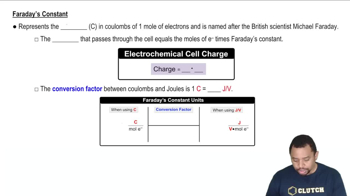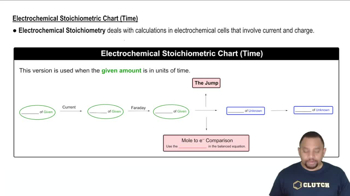Here are the essential concepts you must grasp in order to answer the question correctly.
Electrochemical Reactions
Electrochemical reactions involve the transfer of electrons between chemical species, typically occurring in an electrochemical cell. In the context of a lead storage battery, the conversion of PbSO4 to PbO2 and Pb involves oxidation and reduction processes, where lead ions undergo changes in oxidation states. Understanding these reactions is crucial for calculating the amount of charge transferred during the charging process.
Recommended video:
Faraday's Laws of Electrolysis
Faraday's laws of electrolysis relate the amount of substance transformed at an electrode to the quantity of electric charge passed through the cell. The first law states that the mass of a substance altered at an electrode is proportional to the total electric charge. This principle is essential for determining how long it will take to convert a specific mass of PbSO4 into PbO2 and Pb, given a constant current.
Recommended video:
Faraday's Constant in Electrochemistry
Current and Time Relationship
The relationship between current (I), charge (Q), and time (t) is described by the equation Q = I × t. This relationship allows us to calculate the time required for a specific charge to flow through the circuit. In this scenario, knowing the current (500 A) and the total charge needed to convert the lead sulfate is necessary to determine how long the charging process will take.
Recommended video:
Electrochemical Stoichiometric Chart (Time)





